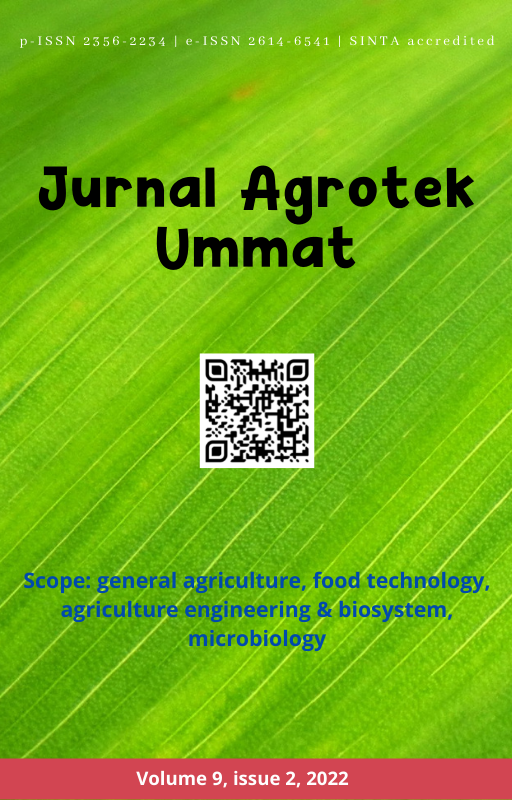Nutrition change of ikan asam pedas in retort pouch with variation of sterilization time
DOI:
https://doi.org/10.31764/jau.v9i2.8247Keywords:
asam-pedas, fish, retort pouch, sterilization time.Abstract
Asam pedas is a soupy food with spices and the main ingredient is thick-fleshed river fish. This food has a low shelf-life, so it is necessary to apply sterilization technology. This research uses catfish as the main ingredient and retort pouch as packaging. This study aimed to determine the best sterilization time for catfish’s asam pedas using retort pouch packaging based on physicochemical and microbiological characteristics. The sterilization time used is 5, 10, 15, 20, and 25 minutes. Parameters observed were fat, protein, pH, thiobarbituric acid (TBA), texture, and Total Plate Count (TPC). The results showed that the sterilization time did not affect fat content, protein content, hardness level, TBA value, and the number of microbes, but the sterilization time significantly affected the pH value of catfish’s asam pedas packaged in retort pouches. Overall, the sterilization process carried out in this study did not change the physicochemical and microbyological characteristics of the catfish’s asam pedas. The best treatment in this study was a sterilization time of 25 minutes with a TPC value of 6.14 x 106 CFU/ml, the protein content of 11.89%, the hardness level of 178.81 gf, the pH value of 6.11, the fat content of 6.27%, and the TBA content of 0.19 mg malonaldehyde/kg.
References
AOAC. (2005). Official Method of Analysis of The Associotion of Official Analitical of Chemist. Association of Official Analytical Chemist, Inc.
Apriyantono, A., Fardiaz, D., Puspitasari, N. L., Sedarnawati, & Budiyanto, S. (1989). Analisis Pangan. IPB Press.
De Garmo, E. P., Sullivan, W. G., & Candra, C. R. (1984). Engineering Economi (7th ed.). Mc Milan Publication.
Fardiaz, S. (1993). Analisis Mikrobiologi Pangan. Raja Grafindo Persada.
Hernowo. (2001). Pembenihan Ikan Patin. Penebar Swadaya.
Izwardy, D., Mahmud, M. K., Hermana, Nazarina, S, M., & Aria, N. (2017). Tabel Komposisi Pangan Indoensia 2017. In Kementerian Kesehatan Republik Indonesia.
Jais, A. S. (2016). Deconstructing Malay Delicacies “Asam Pedasâ€: Critical Ingredients and Flavour. Proceedings of 2016 Festival Agro Makanan Dan Bioteknologi, September, 28–29. https://doi.org/10.13140/RG.2.1.1642.7764
Kusnandar, F., Rahayu, W.P., Marpaung, A.M., Santoso U. (2020). Perspekstif Global Ilmu dan teknologi Pangan. IPB Press.
Lukman, I. N., Huda, & Ismail, N. (2009). No Title. Journal Asian Food and Agro-Industry, 2(2), 171–180.
Majumdar, R. K., Dhar, B., Roy, D., & Saha, A. (2015). Optimization of process conditions for Rohu fish in curry medium in retortable pouches using instrumental and sensory characteristics. Journal of Food Science and Technology, 52(9), 5671–5680. https://doi.org/10.1007/s13197-014-1673-3
Melih Secer, O., Guneser, B. A., & Guneser, O. (2020). Prediction of shelf-life and kinetics of quality changes in canned stuffed grape leaves. Lwt, 132(March). https://doi.org/10.1016/j.lwt.2020.109850
Mugale, R., Patange, S. B., Joshi, V. R., Kulkarni, G. N., & Shirdhankar, M. M. (2018). Heat Penetration Characteristics and Shelf Life of Ready to Serve Eel Curry in Retort Pouch. International Journal of Current Microbiology and Applied Sciences, 7(2), 89–100. https://doi.org/10.20546/ijcmas.2018.702.012
Muhlisin, Kim, D. S., Song, Y. R., Cho, Y. J., Kim, C. J., An, B. K., Kang, C. W., & Lee, S. K. (2013). Effect of cooking time and storage temperature on the quality of home-made retort pouch packed Chuncheon Dakgalbi. Korean Journal for Food Science of Animal Resources, 33(6), 737–743. https://doi.org/10.5851/kosfa.2013.33.6.737
Najih, M. R., Metusalach, & Amir, N. (2018). Pengaruh Kombinasi Lama Waktu dan Suhu Sterilisasi Proses Pengalengan Terhadap Mutu Ikan Bandeng (Chanos chanos) Kaleng. J. Sains & Teknologi, 18(3), 267–273.
Nketia, S., Buckman, E. S., Dzomeku, M., & Akonor, P. T. (2020). Effect of processing and storage on physical and texture qualities of oyster mushrooms canned in different media. Scientific African, 9. https://doi.org/10.1016/j.sciaf.2020.e00501
Nurhikmat, A., Suratmo, B., Bintoro, N., & Suharwadji. (2016). The Effect of Temperature and Time of Sterilization on the F Value and The Physical Cans Conditions in Canned Gudeg. Jurnal Agritech, 36(1), 71–78.
Praharasti, A. S., Herawati, E. R. N., Nurhikmat, A., & Angwar, A. S. M. (2020). Optimasi proses sterilisasi rendang daging dengan menggunakan kemasan retort pouch. March 2020, 463–467.
Shah, M. A., Bosco, S. J. D., Mir, S. A., & Sunooj, K. V. (2017). Evaluation of shelf life of retort pouch packaged Rogan josh, a traditional meat curry of Kashmir, India. Food Packaging and Shelf Life, 12(March), 76–82. https://doi.org/10.1016/j.fpsl.2017.04.001
Waziiroh, E., Ali, D. Y., & Istianah, N. (2017). Proses Termal Pada Pengolahan Pangan. UB Press.
Yuswita, E. (2014). Optimasi Proses Termal untuk Membunuh Clostridium botulinum. Jurnal Aplikasi Teknologi Pangan, 3(3), 5–6.
Downloads
Published
Issue
Section
License
Authors who publish articles in Jurnal Agrotek Ummatagree to the following terms:- Authors retain copyright of the article and grant the journal right of first publication with the work simultaneously licensed under a CC-BY-SA or The Creative Commons Attribution–ShareAlike License.
- Authors are able to enter into separate, additional contractual arrangements for the non-exclusive distribution of the journal's published version of the work (e.g., post it to an institutional repository or publish it in a book), with an acknowledgment of its initial publication in this journal.
- Authors are permitted and encouraged to post their work online (e.g., in institutional repositories or on their website) prior to and during the submission process, as it can lead to productive exchanges, as well as earlier and greater citation of published work (See The Effect of Open Access).

